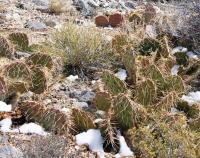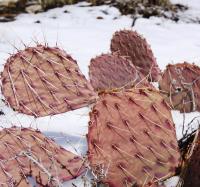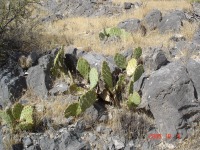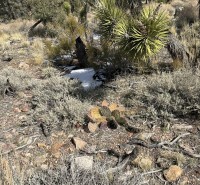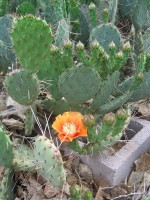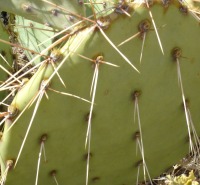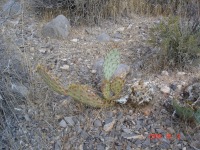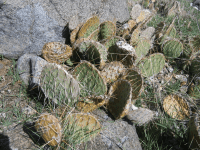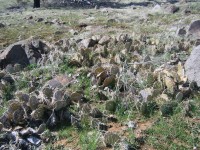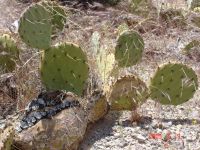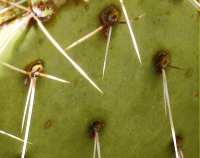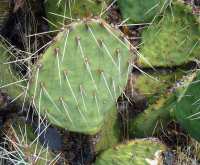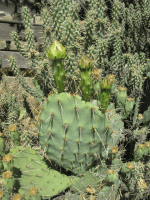
Engelmann & Bigelow, Proceedings of the American Academy of Arts and Sciences 3: 293, 1856
Lectotype; Herbarium (O. mojavensis-like); Herbarium (O. mojavensis-like); Herbarium (O. mojavensis-like); Drawing (The Botany of the Expedition, 1856)
Original Description
What is Opuntia mojavensis?
Opuntia mojavensis is an enigmatic prickly pear cactus. The only historical drawing of this cactus shows 2 spine clusters and an immature or sterile fruit. The lectotype for this prickly pear also has limited material. Some treatments dismiss it for lack of a useful original description.
Details
O. mojavensis forms woody-stiff plants sprawling to 1.5-2(2.5) m across. O. mojavensis has distinctly angular branches caused by its woody nature as well as sometimes-rising branches. Cladodes are irregular in size but generally obovate. The spines shown here seem similar to those of the lectotype as well as in the drawing above. However, spination is irregular, and there are 0-2(3) reflexed spines per areole, even on the same pad. Spines are usually yellow fading to reddish, but may be tan after the first season. If 2 spines, the second, lower spine is shorter and more reflexed. Plants may turn a pleasing pink or red-purple color in winter.
Flowers are 8-10 cm across and yellow with distinct or light red centers, green stigmas, and yellow anthers. Outer tepals may be tinged with red or red-orange. Fruit is reddish and may be barrel-shaped.
Ploidy is unknown.
Other Notes
We observed a population of plants growing at the summit of Mt Potosi (Highway 160 summit) near Las Vegas, Nevada, that we interpret to be O. mojavensis. We base our description of the taxon on that population and on similar plants found further west, mostly in the trans-montane regions of California. The original location (mountains above Victorville/Hesperia, California) matches the Mt Potosi location in general terms of plant companions and altitude but is about 150 miles west of Mt. Potosi. Thus, we envision O. mojavensis as a mountain species above the deserts in southern Nevada and southern California.
Because of its attractive flowers, angular growth shape, and cold-hardiness, O. mojavensis would be interesting in a garden. However, it is a sprawling, large plant.
For more information, see:
Botanist, Root Gorelik, has an entirely different interpretation of O. mojavensis and gives the name a thorough discussion and comes to a different conclusion than us.
Notes on Some Southern California Plants, Author(s): S. B. Parish, Source: Botanical Gazette, Vol. 65, No. 4 (Apr., 1918), pp. 339-340.
In April 1915 I sent living specimens of an Opuntia found in the New York Mountains at Barnwell to Rose, which he identifies as of this species, which in the intervening years had remained known only from the original imperfect specimens.
See Report on the botany of the expedition. O. mojavensis was ignored at first. More recently, the name was proposed for exclusion (Parfitt, Systematic Botany, Vol. 5:408).
On Mojave creek; at the time it was considered identical with the following species [O. camanchica], and no further notice taken of it; only a few fragments were brought home, together with a sterile fruit. Spines 1–2½ inches long, stout, bright-brown; fruit 1¾ inch long, oblong; pulvilli crowded towards the upper end. It is possibly a distinct species, but the material too incomplete to permit us more than merely to indicate it.
More recently, the name was proposed for exclusion (Parfitt, Systematic Botany, Vol. 5:408)








